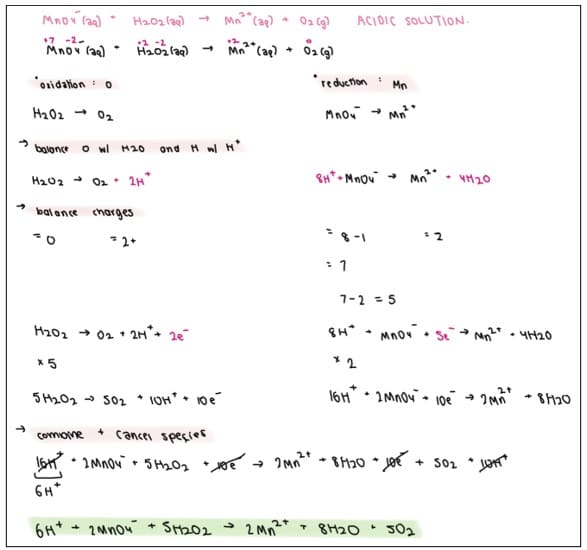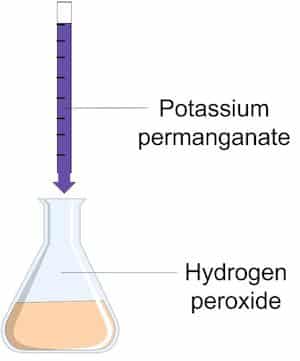Purpose:
To calculate the percentage of H2O2 in a bottle of drugstore hydrogen peroxide by titrating with a standardized potassium permanganate solution.
Background:
Hydrogen peroxide, H2O2, is easily oxidized. It is used in commercial bleaching processes and wastewater treatment plants as an environmentally friendly alternative to chlorine. Dilute solutions of H2O2 are used to bleach hair and clean wounds. Because it readily decomposes in the presence of light, heat, or metallic catalysts into water and oxygen, the quantity of a hydrogen peroxide solution must be checked regularly to maintain its effectiveness. The concentration of hydrogen peroxide can be analyzed by redox titration with potassium permanganate.
Titration is a method of volumetric analysis that uses volume measurements to analyze the concentration of an unknown. The most common types of titrations are acid-base titrations, in which a solution of an acid, for example, is analyzed by measuring the amount of a standard base solution required to neutralize a known amount of the acid. A similar principle applies to redox titrations. If a solution contains a substance that can be oxidized, then the concentration of that substance can be analyzed by titrating it with a standard solution of a strong oxidizing agent.
Oxidation-reduction (redox) reactions involve a transfer of electrons between the species being oxidized and the species being reduced. The reactions are often balanced by separating the reaction components into half-reactions: oxidation (loss of electrons) and reduction (gain of electrons). In a redox reaction, the number of electrons lost by a species being oxidized is always equal to the number of electrons gained by the species being reduced.
In the reaction being studied in this lab, solutions of hydrogen peroxide, H2O2, and potassium permanganate, KMnO4, will be combined in acidic solution. KMnO4, will be used as the titrant to analyze the concentration of hydrogen peroxide in a drugstore bottle. The KMnO4 solution is purple in color, as it is added to the hydrogen peroxide solution, it reacts with the H2O2 to produce colorless Mn2+, and thus the color will fade in the flask. When all the H2O2 has been used up, the last drop of added potassium permanganate will keep its color. The endpoint of the titration is the point at which the last drop of KMnO4 added to the solution causes it to turn pink.
Safety:
H2SO4 is severely corrosive to eyes, skin, and other body tissues. Always add acid to water, never the reverse. KMnO4 is a skin and eye irritant and a strong stain; it will stain skin and clothing. Goggles and aprons should be worn at all times. If solutions are spilled on skin, wash those areas immediately with copious amounts of water. Report all spills to the teacher. Wash hands thoroughly with soap and water after completion of the lab.
Procedure:
- Clean the buret as instructed.
- Fill buret with KMnO4. Be sure to get rid of any air bubbles by opening the stopcock. Discard into waste container. Volume of KMnO4 needs to be below zero mark on buret before starting titration.
- Record the initial volume of KMnO4 to the correct number of significant figures.
- Place 2.00 mL of the hydrogen peroxide solution into a 250 mL Erlenmeyer flask.
- Add about 25 mL of distilled water to the flask.
- Place 5.0 mL of 6 M H2SO4 into the flask.
- Swirl the contents of the flask.
- Titrate the hydrogen peroxide solution with the KnMnO4 solution. Record the final volume of KMnO4.
- Place the contents of the flask into the waste beaker and rinse the flask.
- Repeat Steps 2-8 two more times. You should conduct three trials total.
- Clean buret as instructed. Wash all other used glassware.
- Wipe lab bench with sponge.
- Wash your hands with plenty of soap and water.
Data:
Table 1: Titration of 1.00 mL H2O2 with KMnO4
| Concentration of KMnO4 | |||
| Trial # | Initial KMnO4 Volume (mL) | Final KMnO4 Volume (mL) | Volume KMnO4 Used (mL) |
| 1 | 50.0 mL | 17.8 mL | 32.2 mL |
| 2 | 50.0 mL | 20.3 mL | 29.7 mL |
| 3 | 35.9 mL | 3.3 mL | 32.6 mL |
Pre-lab:
What is a titrant? What is the titrant in this lab?
When titration, a known concentration solution is called a titrant. It is added to the analyte, which is a solution of unknown concentration. Its reaction with the analyte is used to calculate its concentration. This experiment uses the standardized potassium permanganate (KMnO4) solution as the titrant.
What is an analyte? What is the analyte in this lab?
The solution of an unknown concentration being analyzed and titrated in a chemical reaction is known as an analyte. The H2O2 solution of hydrogen peroxide serves as the analyte in this experiment.
Balance the following redox reaction in acidic solution – MnO4 ‒ (aq) + H2O2(aq) → Mn2+(aq) + O2(g)
- Balanced reaction?
6H+ +2MnO4- + 5H2O2 →2Mn2+ + 8H2O + 5O2
How many electrons are transferred in this reaction?
10 electrons
What species is being oxidized? What species is being reduced?
Oxidation: O
Reduction: Mn

Post-lab and Data Analysis: KMNO4
- Calculate the average volume, in milliliters, of KMnO4 used to titrate 1.00 mL of hydrogen peroxide solution.
32.2 mL + 29.7 mL + 32.6 mL / 3 = 31.5 mL = 0.0315 L
- Using the average volume of KMnO4 and the molarity of KMnO4, determine the moles of KMnO4 used to titrate 1.00 mL of hydrogen peroxide solution.
N of KMnO4 = avg volume x concentration of KMnO4
N of KMnO4 = 0.0315 L x 0.02 M
N of KMnO4 = 6.3 x 10-4
- Calculate the moles of H2O2 that were present in 2.00 mL of hydrogen peroxide solution.
Balanced equation – 2MnO4– + 5H2O2 + 6H+ → 2Mn-2 + SO2 + 8H2O
N of H2O2 = 5/2 x 6.3 x 10-4
N of H2O2 = 0.001575 = 1.58 x 10-3
- Calculate the grams of H2O2 that were present in 1.00 mL of hydrogen peroxide solution.
Grams of H2O2 = moles of H2O2 x molar mass of H2O2
Grams of H2O2 = 1.58 x 10-3 x 34.0147 g/mol
Grams of H2O2 = 0.05374 = 5.37 x 10-2 g
→ The amount of grams that were present of hydrogen peroxide was 0.408g.
- Assume the density of the H2O2 solution to be 1.00 g/mL, calculate the percentage of H2O2 in solution.
Density % = (H2O2/total) x 100%
Density % = (0.05374g / 2 g) x 100%
Density % = 2.69%
- The accepted percentage of hydrogen peroxide in solution is 3.00%. Calculate the percent error
Percent error = experimental – accepted / accepted
Percent error = ([2.69- 3.00] / 3.00) x 100%
Percent error = 10.33%
- How would the concentration of the H2O2 solution have been affected if the following observations were made about the Erlenmeyer flask? Justify your answers.
- When the titration was completed, the solution in the flask was colourless
- Not enough KMnO4 (standard solution) was titrated
- Concludes that the concentration is too low
- Hence reacts slowly
- When the titration was completed, the solution in the flask was dark red or purple.
- A lot of KMnO4 (standard solution) was added
- Went beyond the equivalence point
- Excess KMnO4 did not react, and has a dark purple colour
- Concludes that concentration is too high

